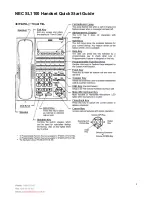
WS10
WS10 Series
W AT E R S E N S O R
s e r v i c e
i n s t r u c t i o n s
ENGLISH
5
5. MAINTENANCE
5.1 Sensor
cleaning
Cleaning of the measuring head is recommended
before use with another fluid and prior to
calibration. Do not touch or rub the sensing
element during the cleaning process!
Cleaning of sensor from oil residue:
1) Immerse only the measuring head in
N-HEPTAN and swirl for approx. 30 seconds.
Do not use solvents such as acetone.
2) Remove excess liquid and allow to air dry for
approx. 2 minutes.
5.2
Self-diagnostic and error messages
LED D1 (blue):
- constantly lit => sensor element damaged
- flashing => sensor element bedewed (Wet with
free water)
6. ORDERING
INFORMATION
3.
INSTALLATION
3.1 Installation
location
The Water Sensor enclosure is designed in
modular form for safe and convenient installation.
The M12 connector allows for electrical wiring of
the Water Sensor for power and sensor output.
Each section of the enclosure fits securely to
achieve at least IP65 moisture protection rating.
Select a location that offers optimum measuring
conditions, the oil must be representative of the
system as a whole and must be able to circulate
freely around the sensing element. Mount the
transmitter directly into the circulating system,
in a pipe that is always full of oil. Reservoir
mounting is not ideal unless the reservoir
residence time is short.
3.2
Installing the probe directly into the process
When installing a probe directly into the process,
there should be a stop valve on both sides of the
point of installation.
This makes it easy to remove the transmitter for
maintenance and calibration.
Step 1:
Install the probe with the
stop valves closed.
It is not permitted to use a sealing
ring with a NPT 1/2" thread.
Appropriate PTFE sealing tape or
sealant should be used instead.
Step 2:
Insert the probe into the
process and screw it as tight as
possible by hand.
Step 3:
If there is a sealing ring,
check it for correct centering and
tighten the screw connection with
a torque of 30 Nm.
4.
ELECTRICAL CONNECTIONS
Male connector
1 V+
2 output 1
3 GND
4 output 2
4
G
ND
V+
3
1
2
mA
mA
Warning:
It is strongly advised NOT to try cleaning the sensor
by mechanical means, such as rubbing the sensor
with any type of wiper!
Water Sensor P/N: WS10 S
Table 1
Table 2
Table 1: Relay Options
Code
Probe Options
B08
½ NPT connector
C08
½ BSPP connector
Table 2: Probe Options
Code
Pressure Options
None
20 bar (290 psi) Standard
H
100 bar (1450 psi) High Pressure


























